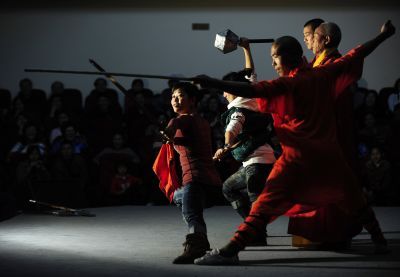China's Shaolin Temple rakes in cash and controversy

"An enchanting place, home of the warriors," promises the pop music blaring from a giant screen as excited visitors board buggies fit for a theme park.
Welcome to the Shaolin Temple in central China, known as the birthplace of Zen Buddhism and world-famous for its kungfu.
It is a place that has inspired awe and mysticism through the centuries but has lately attracted controversy in China over charges of rampant commercialism.
"The first time I came here, I thought the taxi driver had made a mistake. I thought I'd see a monastery deep in the forest, and I was very disappointed," said Julie Desjardins, a French tourist and kungfu enthusiast.
The Shaolin Temple was established in 495 AD. According to legend, prince-turned-monk Bodhidharma from India later came to Shaolin and meditated for nine years in a mountain cave behind the temple, founding Chinese Zen.
The monastery has been destroyed and rebuilt several times over the centuries. In 1928, a warlord attacked the temple, which burnt for 45 days, destroying many of the buildings, books and records.
During the radical political campaigns of the turbulent 1966-76 Cultural Revolution - when religion was basically banned - still more buildings, statues, and relics were destroyed.
But in recent decades China has allowed the religion to develop again, albeit within strict parameters, and Buddhism has rebounded dramatically, allowing for the reconstruction or restoration of many of the temple structures.
Shaolin last year drew 1.6 million people who paid 100 yuan (15 dollars) to pass through its Disneyland-style turnstiles in Henan province, watch a half-hour kungfu show and take photos with performers for another 20 yuan.
The temple makes millions every year from entrance fees, online sales of Shaolin items such as nunchakus, spearheads, fans and clothing, and its travelling performing troupes.
Its fame has been a boon to the neighbouring area, attracting more than 80 mostly private kungfu schools, where more than 60,000 people train to be like the monastery's 200 warrior-monks.
On a recent visit, Nie Rui of Henan province found the temple more rowdy than she would have expected from the epicentre of Zen Buddhism, but the commercial aspect did not dampen her enjoyment.
"When tourists come here, there are so many people that they don't feel it's that calm," said Nie, 24.
"But I still like it."
The temple's money-making success is largely attributed to abbot Shi Yongxin, a small, plump monk who took charge in 1999.
Dubbed the "CEO of Shaolin," he has been repeatedly criticised for his perceived pursuit of money.
Last month, a hacker replaced the Shaolin website's front page with a mock letter of remorse in Shi's name, state press reported. The post accused him of commercialising the 1,500-year-old temple.
"I'm not a businessman, I don't hold shares," Shi told AFP, as he sat for an interview wearing a yellow robe in one of the temple's halls.
"The Shaolin temple is just like a family. There are old people, young people, it's like a big family," he added, his gentle demeanour standing in sharp contrast to the stern expression on his face.
Shi also defended Shaolin's commercial ventures, which he refused to describe as businesses, but rather as ways of raising the temple's profile.
"Believers have demands, and we must satisfy and serve them to the best of our ability - it's a service that provides faith products," he said of the temple's online sales.
Still, some Shaolin events have raised eyebrows.
In 2006, parts of a reality TV contest to find a new kungfu star were shot there, while a bikini fashion show this summer caused controversy.
But Gene Ching, the US-based publisher of Kung Fu Tai Chi - a periodical devoted to Chinese martial arts - and a former student at Shaolin, defended Shi, saying he was moving with the times.
"Shaolin is a medieval monastery that is trying to remain vital and meaningful in today's modern world," he said.
Ching said that before Shi took over, the grounds of Shaolin were full of tourist traps such as a terracotta Buddha with a house of horrors inside, a roller skating rink, video game arcades and karaoke bars.
"That's what it looked like when I first went in 1995. It was less like Disneyland, more like a surreal circus carnival," he said.
"When Abbot Yongxin was inaugurated, his first act was to purge Shaolin of all that... The process took several years... (and) caused a lot of animosity."
Subscribe to Independent Premium to bookmark this article
Want to bookmark your favourite articles and stories to read or reference later? Start your Independent Premium subscription today.

Join our commenting forum
Join thought-provoking conversations, follow other Independent readers and see their replies